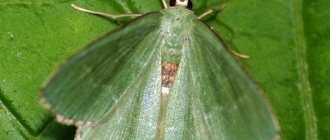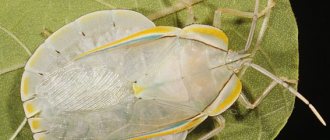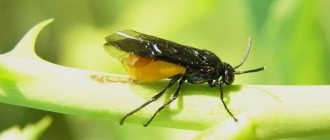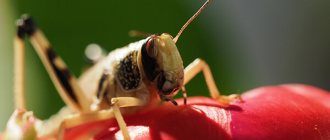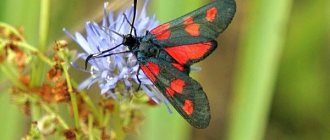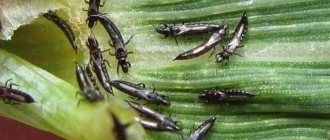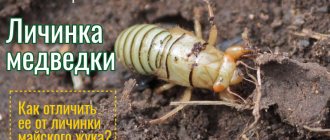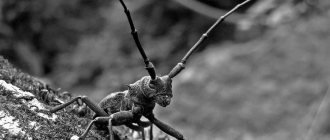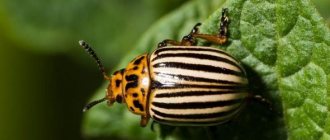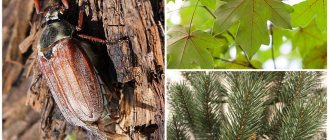The Colorado potato beetle is one of the most famous pests of agricultural crops, a real disaster for potato plantings. The insect is characterized by amazing vitality, quickly adapts to environmental conditions, and gets used to toxic chemicals. This causes certain difficulties in combating the pest, but there are still effective ways to save the potato harvest.
Origin and history of appearance in Europe and the Russian Federation
Surely many gardeners from time to time wonder where this disaster came from - the Colorado potato beetle. These insects were discovered in the 20s of the 19th century. Their homeland is Mexico. It was from there that, moving north, hordes of beetles spread across North America, where they adapted to eat the potatoes grown by the settlers. Colorado potato beetles got their name after they destroyed potato crops in Colorado in 1859.
The pests quickly spread across North America, and then crossed the ocean with cargo on ships and entered Europe. In the USSR, the first Colorado potato beetles appeared in the late 40s of the 20th century. Nowadays, the Colorado potato beetle is widespread throughout the European part of Russia.
Resistant varieties
Potatoes that would not be interesting to the Colorado potato beetle do not exist in nature, but breeders have managed to develop several varieties with dense, coarse foliage and a sharp, repellent odor. Due to this, the insect does not like them very much. If the beetle has a choice, it will make it in favor of other, more attractive varieties. That is why many potato growers prefer to grow potatoes such as Lasunok, Temp, Zarevo, Kamensky, Nikulinsky or Utro Previously. These hybrids are highly resistant to the pest. Even a massive invasion of striped fish into fields and vegetable gardens has virtually no effect on their productivity.
The Colorado potato beetle is very tenacious and is capable of quickly restoring the population, so the fight against it must be comprehensive and constant. Plant protection should be done not only when it appears in the garden. It is carried out throughout the entire season, starting with the processing of planting tubers and ending with deep autumn plowing of the site, after which a significant part of the insects die.
Description of the pest
The Colorado potato beetle (lat. Leptinotarsa decemlineata) belongs to the family of leaf beetles. Insects are medium in size from 8 to 12 mm. The beetles have an oval, convex yellow body, light elytra with black stripes, and a darker orange head with black spots. All insects of this species have well-developed wings, so the beetles can fly over considerable distances. Like other representatives of the insect class, beetles have 3 pairs of legs and articulated antennae.
Appearance
The Colorado potato beetle larva looks like a thick worm with a short, soft body. At first they are yellow-pink, but as they grow older they become red-brown due to carotene accumulating in the tissues. The head is black, there are 2 rows of black dots on the sides of the body.
Favorable and unfavorable conditions for the pest
The Colorado potato beetle does not have a constant body temperature; its existence depends on the climate in its habitat - heat, moisture and light. The mechanical composition of the soil also affects.
For the successful development of an insect from the egg stage to the adult, the air temperature should be in the range of 24–26 ° C, and the air humidity should be 60–75%. When these indicators change up or down, the development of the population slows down. The number of born larvae decreases both in cold rainy weather and in hot and dry periods. Many first instar larvae die during heavy rainfall and gusty winds. In such conditions, they are unable to move around in search of food.
The pupation process is affected by soil moisture. In hot and compacted soil, some larvae cannot penetrate deeper and die on the surface, and some adults cannot climb up.
With excess soil moisture, pupation occurs in the upper layers of the soil and this also affects the number of young beetles.
Sandy and sandy loam soils are most favorable for the development and wintering of beetles..
Life cycle and reproduction of the Colorado potato beetle
Colorado potato beetles are insects with complete metamorphosis. They go through 4 stages of development (egg, larva, pupa, adult). Mating occurs in the spring, immediately after the insects emerge from hibernation and emerge from the ground, where they spent the entire cold season.
Colorado potato beetle eggs
The fertilized female lays eggs on the underside of the leaves. There are from 30 to 70 eggs in one clutch, and in just one season the female lays up to 1,000 eggs (usually 500–700). The eggs of the Colorado potato beetle are elongated and light orange in color. They develop from 6 to 18 days depending on the temperature and humidity of the environment. Optimal conditions are temperature from +20 to +22⁰С, humidity about 70%.
Larvae
Having emerged from the eggs, the Colorado potato beetle larvae eat the remaining shell. They can also eat eggs with embryos. Then they switch to plant food - first they gnaw the pulp of the leaf from the bottom side, then crawl to the top.
Larva
The larvae develop quickly, go through 4 instars, between which they molt three times. Older larvae are very voracious; they eat almost around the clock. After 15–20 days, the larva burrows into the ground, where it pupates.
Pupae and adults
The development of the Colorado potato beetle in the pupal phase occurs at a depth of 10–15 cm. This stage takes from 12 to 20 days, after which an adult insect is born. If the transformation occurred at the beginning of summer, the beetles crawl to the surface and begin to reproduce. Young insects that appear in late summer and early autumn remain underground for the winter.
What is a larva?
If you have ever grown potatoes, then you know very well that the greatest damage to plantings is caused not by adult Colorado potato beetles, but by their voracious larvae. They eat not only potatoes, but also all plants of the nightshade family: tomatoes, eggplants, fragrant tobacco, and do not disdain garden petunia and some other plants.
What do the larvae of the familiar Colorado potato beetle look like? They are completely different from adults. This is an insect whose back is curved like a crescent, and its abdomen, slimy and swollen in the center, is flattened. The larvae are large, more than one and a half centimeters, orange-red in color.
As the insect gets older, it changes its color to pure orange with black dots arranged in two rows on the sides of the body.
While the larva is young, it eats leaves from the bottom of the plants, but as it matures, it rises higher along the stem and devours not only young twigs and shoots, but also entire leaves, and then moves on to those plants that are sitting in the bed nearby.
The adult Colorado potato beetle itself is not as nasty as its larva. Let's take a close-up look at it:
The life of a potato beetle goes like this:
- In the fall, the fertilized female goes into hibernation, and in the spring, as soon as she wakes up, she lays eggs on young potato bushes.
- The eggs will hatch into larvae in two or three weeks;
- The larvae will go through four stages of development, each of which is marked with a special color and ends with a moult.
- In the first phase, the small hatched larva is gray-yellow in color and covered with thick hairs, eating only the most tender pulp of young leaves.
- The larva enters the second stage having lost part of its hair and changed color to red-orange, but is already capable of eating coarser leaves, eating them away to a “skeleton” state, leaving veins.
- The third stage is brick-colored, the larva already grows almost a whole centimeter.
- The fourth phase is a large individual measuring from 10 to 15 millimeters and yellow-red in color;
- Having gained strength, the larva goes underground, where it pupates. There it is reborn into a full-fledged insect up to a centimeter or up to 12 millimeters in size with a very rigid body.
- If degeneration occurs before winter, then the Colorado potato falls asleep and appears on the surface of the soil during the warm period; if in the summer, then it crawls out and continues to eat the foliage and stems of plants. The incubation period of the larvae lasts from ten to 14 days. The beetle is capable of not only crawling, but also flying over long distances.
In this video you can see almost the entire life cycle:
There is another beetle, the false Colorado potato beetle, with which it can be confused. It is widespread not here, in Russia, but in America. Some time ago it was believed that such an insect did not pose a threat to potato plantings, but studies have shown that it also likes all nightshade plants.
How to fight?
Various methods are used to combat Colorado potato beetles:
- mechanical (collecting insects by hand, inspecting plants for the presence of egg laying);
- biological (attracting natural enemies, using biological products);
- chemical (use of insecticides).
Collecting beetles
As for special means, they can be used for processing seed, for spraying bushes, for applying to the soil.
What crops does the pest affect?
Adults and larvae of the pest destroy the leaves of plants from the nightshade family: potatoes, eggplant, sweet peppers, tomatoes, physalis . Eating leaves and leaving bare stems, Colorado potato beetles move from one plant to another. Young beetles are the most voracious; they do not leave petioles or stems.
If there are no favorite plants nearby, pests can settle on peonies, lilies and spirea . They feed on the leaves and buds of these plants and lay eggs on them.
Natural enemies
The leaves and shoots of nightshade contain the alkaloid solanine. This substance gradually accumulates in the tissues of pests that feed on nightshade crops. It is precisely because of the presence of a toxic compound in the body of Colorado beetles that few people eat them. Colorado beetle larvae are eaten by:
- poultry (turkeys, pheasants, partridges, guinea fowl);
- wild birds (crows, starlings, sparrows);
- insects (lacewings, ladybugs, ground beetles, shield beetles).
The natural enemies of adult Colorado potato beetles are guinea fowl, but other birds can also be accustomed to this food by regularly adding insects to their food.
Facilities
Bitoxibacillin
Poison from the Colorado potato beetle and larvae Bitoxibacillin is used at a temperature of at least 18 degrees. The dosage is 50-100 g. for 10 liters of water. Plants should be treated 3 times per season at weekly intervals.
The drug makes the larvae lethargic, they stop feeding, and spores begin to appear in their stomach, which turn the larva into a pouch. From such sacs a beetle appears that is not capable of reproduction.
Bicol
How to destroy Colorado potato beetle larvae with Bicol? Plants need to be sprayed with this preparation up to 3 times per season. The dosage is 20 g. for 10 liters of water. The interval between watering should be a week.
Colorado
Each generation of beetles is treated with poison from the Colorado potato beetle and Colorado larvae 2 times at intervals of a week . The dosage for 10 liters of water is 150 grams.
Fitoverm
The newest drug, when a larva enters the body, causes paralysis and then death. 10 hours after treatment, the larvae stop feeding and die within 3-6 days. The drug does not affect beetle eggs.
There are also toxic chemicals available for sale from Colorado potato beetle larvae: Bankol, Confidor, Aktara and others. Manufacturers claim that they are absolutely safe for the human body and do not have time to get there, breaking down into non-toxic substances.
If you have doubts about the safety of the crop, it is better to use biological means or the old mechanical method.
If you find an error, please select a piece of text and press Ctrl+Enter.
Preventive measures
Fighting the Colorado potato beetle is not easy. The voracious insects spread rapidly, causing enormous damage. Preventive measures will help protect potatoes from the pest. The most effective measures:
- choose for planting the most pest-resistant varieties or varieties with a high degree of regeneration;
- germinate tubers to speed up the growth of bushes;
- plant potatoes early so that by the time the beetles appear, the tops have already grown;
- when planting, put a little onion peel in the hole, the smell of which repels insects;
- follow the rules of crop rotation;
- loosen the soil, remove weeds;
- plant plants with a strong smell (mint, coriander, dill, lemon balm, horseradish) next to potatoes.
Be sure to regularly inspect the bushes for pests (it is better to do this early in the morning).
Agrotechnical techniques and the use of natural enemies
The rules of potato agricultural technology are aimed not only at adequate nutrition and crop formation. Compliance with them also involves protecting the plant from pests, for this:
- Crop rotation must be observed;
- carry out early planting of healthy and immunized seed material - a strong, formed bush is not afraid of damage, it will not affect the formation of the crop;
- Hill up high (helps destroy insect pupae, and on young shoots - significantly reduces brood from oviposition);
- mow the tops when the tubers have already formed;
- regularly loosen the soil deeply before the onset of cold weather.
Alternatively, natural enemies can be used: guinea fowl or chickens. Just first they need to be accustomed to such food and not treat the plantings with toxic drugs. The ladybug, which has larvae similar to the Colorado potato beetle, will also be useful. It is believed that they are malicious enemies who willingly destroy the egg-laying pest.
Appearance of a beetle
There are 24 species of these insects. There is probably no person who does not know what a cockchafer looks like. The least harm to plants comes from representatives of the Caucasian and Oriental species. Western beetles are the biggest nuisance to gardeners and gardeners.
The Western Khrushchev is brownish-yellow in color, with a black chest, red back and legs, and has a mustache with a brown “mace.” The length of the insect is from 25 to 35 millimeters. The larva of the May beetle is often white-yellow in color, fleshy, folded, and has a dark head with two clamping fangs. Beetle eggs are oval and white. The male can be distinguished from the female by the appearance of the back of the abdomen. In male chafers it looks like a long triangular process, which is much shorter in the female. The body of the beetle is covered with a chitinous shell.
Interesting Facts
- The Colorado potato beetle flies mainly in the presence of wind and is capable of reaching speeds of up to 7 km/h.
- These insects are able to survive the harshest winter, since an adult individual can go into the ground to a depth of about 70 cm.
- A record holder for survival, he overcomes the hungry years by going into a pause for 3 years.
- When the Colorado potato beetle senses danger, it falls on its back and pretends to be dead.
- The larvae are colored intense orange, since the main coloring substance in their body is carotene.
- The accumulation of toxins on the body of the pest makes it practically invulnerable, for this reason it has very few natural enemies.
